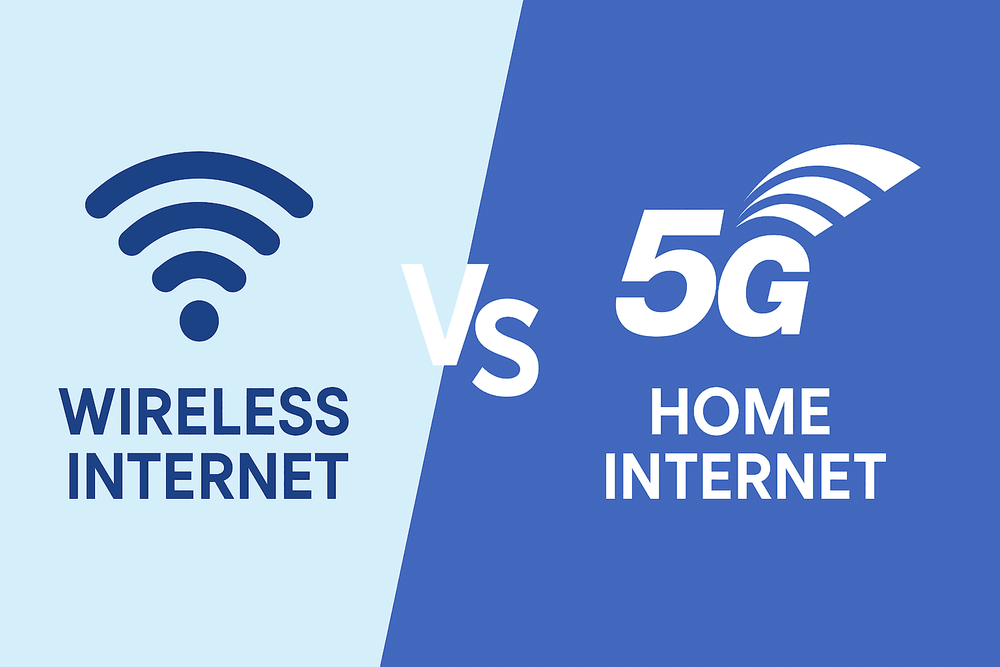Wireless Internet Vs 5g Home Internet: Pros & Cons (2025 Guide)
Jatin Shankar Srivastava
Compare Wireless Internet and 5G Home Internet in the US. Learn pros, cons.

Wireless Internet vs 5G Home Internet: Pros & Cons (2025 Guide)
Introduction
Internet selection for your home can be overwhelming in 2025. With traditional wireless internet services and new 5G home internet, homeowners are unsure of speed, reliability, price, and coverage.
This guide contrasts Wireless Internet with 5G Home Internet, explaining pros, cons, and which option is best for various US household types.
What is Wireless Internet?
Wireless Internet is internet connectivity that is based on radio signals, as opposed to the usual wired connections. This encompasses:
- Fixed wireless providers
- Satellite internet (e.g., Starlink, HughesNet)
- LTE home internet
Advantages of Wireless Internet
- Accessible in rural and underserved areas where fiber/cable isn't present
- No need for wiring — fast installation
- Can be mobile (some devices have outdoor or mobile configurations)
- Usually less expensive where there is no high-speed fiber
Disadvantages of Wireless Internet
- Slower speeds than 5G or fiber in city centers
- High latency → not suitable for games or real-time uses
- Interference problems → signal strength reduced by weather, obstructions, or network congestion
- Data caps are typical with satellite companies
What is 5G Home Internet?
5G Home Internet is the new-generation high-speed wireless internet supplied through 5G cellular networks. Verizon, T-Mobile, and AT&T are among the providers that supply home internet plans using 5G signals rather than fiber or cable.
Advantages of 5G Home Internet
- Fast connectivity: Standard speeds 100–500 Mbps; peaks to 1 Gbps in some locations
- Low latency (10–30 ms) → perfect for gaming, video conferencing, and streaming
- No wired installation → speedy setup, plug-and-play routers
- Scalable for multiple devices → can handle numerous smart home devices
Disadvantages of 5G Home Internet
- Coverage limited: Best suited in urban/suburban areas; rural coverage is sparse
- Signal sensitivity: Interference from obstructions such as walls and weather affects speed
- Cost: Monthly subscription can be more expensive than traditional wireless, depending on the carrier
- Data caps or throttling: Some carriers might restrict speed after reaching specific thresholds
Key Differences: Wireless vs 5G Home Internet
| Feature | Wireless Internet | 5G Home Internet |
|---|---|---|
| Speed | 25–150 Mbps | 100–500 Mbps (up to 1 Gbps) |
| Latency | 50–100 ms | 10–30 ms |
| Coverage | Rural areas, underserved regions | Urban/Suburban, gradually expanding |
| Installation | May need antenna or satellite dish | Plug-and-play 5G router |
| Cost | Usually cheaper in rural areas | Moderate to high depending on plan |
| Reliability | Affected by weather/interference | Generally stable in covered areas |
| Best For | Basic browsing, small households | Gaming, HD streaming, smart homes |
When to Opt for Wireless Internet
- You reside in a rural or remote location with limited or no 5G coverage
- Tight budget requires lower-cost wireless plans
- Light internet needs: browsing, emails, regular video streaming
When to Opt for 5G Home Internet
- You reside in urban/suburban areas of the US where 5G coverage is robust
- You require low-latency, high-speed connections for gaming, Zoom calls, or several devices
- You prefer a plug-and-play setup without cable/fiber installation
Tips to Maximize Your 5G Home Internet
- Position your 5G router close to windows or upper floors for improved signal
- Utilize WiFi 6 mesh systems to cover more areas in larger homes
- Keep an eye on network congestion during busy hours
- Contrast Verizon, T-Mobile, and AT&T plans on speed, price, and coverage
FAQ: 5G Questions Answered
What is 5G?
5G is the fifth-generation wireless standard that offers faster speeds, lower latencies, and higher capacity than 4G LTE. It enables home internet, smartphones, and IoT devices.
What does 5G UC mean?
5G UC is 5G Ultra Capacity, a faster version of 5G found in some US cities. It offers quicker speeds and more consistent connections than normal 5G.
What does 5G UW mean?
5G UW (Ultra Wideband) is millimeter-wave (mmWave) 5G networks. They offer very fast speeds in high-density areas but have shorter range.
What 5G UC means in simple words?
It just means your 5G mobile or home device is linked to a high-speed ultra capacity network, enabling improved gaming, streaming, and downloads.
How 5G works?
5G does this by employing higher-frequency radio waves, more sophisticated network architecture, and low-latency infrastructure to transmit quicker and more stable wireless connections.
Are 5G towers safe?
Yes, 5G towers radiate radio frequencies within international safety guidelines. No reliable evidence connects 5G exposure to health risks.
Where are 5G towers nearby?
You can refer to provider coverage maps such as Verizon, T-Mobile, and AT&T to see where 5G towers and services are available in your location.
Where was 5G initially rolled out globally?
5G was initially rolled out commercially in South Korea in 2019, then followed by the US, China, and other nations.
Can 5G trigger headaches?
There is no scientific basis that 5G induces headaches or any other health problems. A few are sensitive to wireless signals, which is very rare.